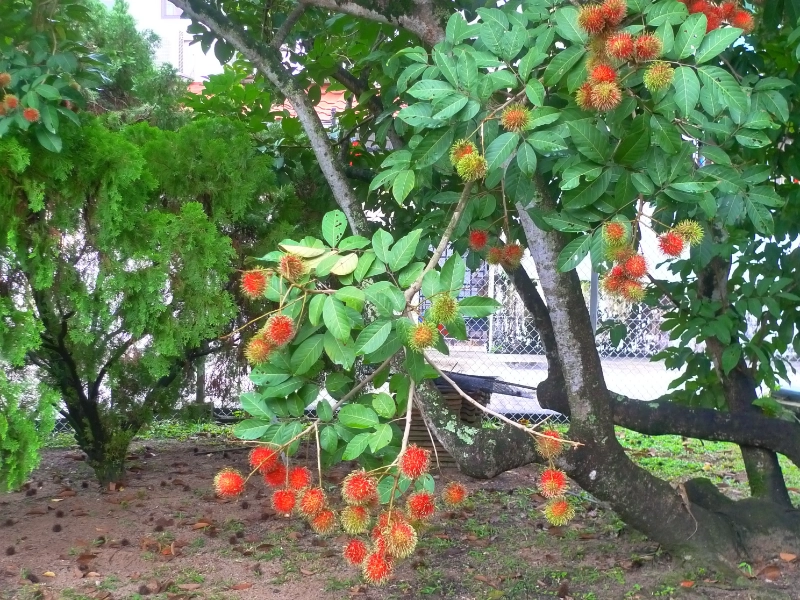Rambutan Tree Care: Tips for a Bountiful Harvest
Any gardener or fruit lover may find great satisfaction in tending to rambutan trees. Rambutans, well-known for their vivid red and hairy appearance, are not only great but also loaded in minerals. Good upkeep and care for these tropical trees guarantees a year-round abundance. Covering all from planting and watering to insect control and trimming, this page offers basic advice on how to grow healthy rambutan trees.
Choosing the Correct Location
 Advertisement
Advertisement
The development and output of your ramboutan tree depend on its chosen location. Rambutan trees are happiest in warm, tropical environments with lots of sunlight. They should ideally be grown in a spot with at least six hours of direct sunlight. The ground should be rich in organic materials, well-draining, somewhat acidic to neutral in pH. Rambutan trees find especially fit Sandy loam or clay loam soils. Evaluate the drainage of your selected location before starting any planting project. Should the location typically retain water, think about building mounds or raised beds to enhance drainage. Furthermore make sure the site is sheltered from strong winds since rambutan trees can be damaged easily. If you live in a cooler environment, think about putting your ramboutan tree in a container or greenhouse you could transfer indoors in cooler months. Choosing the proper site can help your rambutan tree have a solid basis for growth.
Correct Gardening Methods

Planting your ramboutan tree comes first once you have selected the proper site. First dig a hole twice the width and depth of the tree's root ball. This lets the roots expand readily and settle into the nearby soil. To promote development, gently free any firmly tied roots before burying the tree. Plant the tree such that the root flare is level with the ground surface; too deep planting can cause root rot. Backfill the hole with a mixture of native soil and organic compost to supply vital nutrients once the tree has been placed there. To eradicate air pockets and guarantee adequate soil contact, thoroughly water the tree. Mulching the base of the tree will help to control weeds and preserve moisture. Mulch should not be piled too near to the trunk since this can draw pests and illnesses. Good planting methods create the conditions for robust development and higher fruit output.
Fertilizer and Watering
Particularly in their early years of growth, rambutan trees need constant rainfall. Either once or twice a week, thoroughly water the tree; let the soil dry somewhat between waterings. You might have to water more often to avoid stressing the tree during hot, dry spells. Still, be careful not to overwater since wet ground could cause root rot. Rambutan trees cannot flourish without fertilization either. Applied every two to three months during the growing season, use a balanced fertilizer with nitrogen, phosphorous, and potassium. Furthermore supplying the required nutrients are organic choices such well-rotted manure and compost. Apart from consistent fertilization, think about including micronutrients like magnesium and zinc, which are essential for good development of fruits. Correct fertilization and watering techniques will encourage rich development and plenty of fruiting.
pest control
Rambutan trees can be vulnerable to pests and diseases, much as any fruit tree is. Common pests that could ruin fruit and leaves include aphids, fruit flies, and scale insects. Look at your tree often for indications of an infestation, such fruit drop or discoloured leaves. If you see pests, think about introducing ladybugs or organic insecticides to help to organically control the population. Apart from controlling pests, you also have to keep appropriate hygienic conditions surrounding your ramboutan tree. Clear dropped fruit and trash since these might attract pests and diseases. Additionally lessening the possibility of infestations is pruning your tree to increase air circulation and sunshine penetration. Your rambutan tree will be kept safe and a good yield guaranteed by keeping alert and using integrated pest control techniques.
Pruning for Efficiency and Health
A major component of rambutan tree maintenance, pruning encourages good development and fruit output. Eliminating dead or broken branches often promotes fresh growth and increases tree air circulation. Before the growing season starts, prune your rambutan tree either late winter or early spring. Emphasize on forming the tree to let light pass through the canopy, which is necessary for the growth of fruits. Use neat, sharp instruments while pruning to make precise cuts and reduce tree stress. Remove branches that cross or compete with one another to help to preserve a balanced framework. Through better ventilation, this habit not only improves the look of the tree but also lowers its disease risk. Regular pruning of your rambutan tree will help to preserve its health and productivity, therefore promoting a more plentiful crop.
methods of harvesting
Enjoying your ramboutan fruit depends on knowing when and how to pick it. Depending on the species and growth conditions, rambutan fruit usually ripens 4 to 5 months following flowering. When the skin becomes a vivid red or yellow and feels just little soft to the touch, the fruit is ready for picking. Carefully twist or cut the fruit from the cluster, being sure not to injure the tree or other fruit. Handle the rambutan fruit gently once picked to prevent bruising. Store the fruit refrigerated to extend freshness or in a cold, dry environment. Fresh rambutan is delicious; it can also be used in desserts or mixed into fruit salads. Learning the craft of harvesting will help you to appreciate the delicious results of your labor and enjoy the plentiful crop from your ramboutan tree. Taking care of ramboutan trees calls for choosing the correct site, appropriate planting, consistent watering and fertilization, good pest control, frequent trimming, and timely harvesting in general. Following these guidelines will help you to grow healthy rambutan trees producing mouthwatering fruit, so guaranteeing a good and pleasurable gardening environment.










